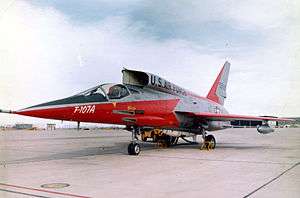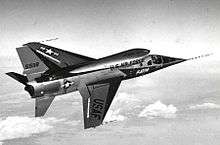North American F-107
| F-107 | |
|---|---|
 | |
| Role | Fighter-bomber |
| National origin | United States |
| Manufacturer | North American Aviation |
| First flight | 10 September 1956 |
| Retired | 25 November 1957 |
| Status | Canceled |
| Primary users | United States Air Force NACA |
| Number built | 3 |
| Program cost | US$105.8 million[1] |
| Developed from | North American F-100 Super Sabre |
The North American F-107 was North American Aviation's entry in a United States Air Force tactical fighter-bomber design competition of the 1950s. The F-107 was based on the F-100 Super Sabre, but included many innovations and radical design features, notably the over-fuselage air intakes. The competition was eventually won by the F-105 Thunderchief, and the F-107 prototypes ended their lives as test aircraft.
Design and development
In June 1953, North American initiated an in-house study of advanced F-100 designs, leading to proposed interceptor (NAA 211: F-100BI denoting "interceptor") and fighter-bomber (NAA 212: F-100B) variants.[2] Concentrating on the F-100B, the preliminary engineering and design work focused on a tactical fighter-bomber configuration, featuring a recessed weapons bay under the fuselage and provision for six hardpoints underneath the wings. Single-point refuelling capability was provided while a retractable tailskid was installed.[3] An all-moving vertical fin and an automated flight control system were incorporated which permitted the aircraft to roll at supersonic speeds using spoilers.[4] The flight control system was upgraded by the addition of pitch and yaw dampers.[3]

The aircraft's most distinguishing feature is its dorsal-mounted variable-area inlet duct (VAID). While the VAID was at the time a system unique to the F-107A, it is now considered to be an early form of variable geometry intake ramp which automatically controlled the amount of air fed to the jet engine.[5] Although the preliminary design of the air intake was originally located in a chin position under the fuselage like the Vought F-8 Crusader, the air intake was eventually mounted in an unconventional position directly above and just behind the cockpit.[6] The VAID system proved to be very efficient and NAA used the design concept on their A-5 Vigilante, XB-70 Valkyrie and XF-108 Rapier designs.[7]
The air intake was in the unusual dorsal location as the Air Force had required the carriage of an underbelly semi-conformal nuclear weapon. Some sources claim that the original chin intake caused a shock wave that interfered in launching this weapon, but no such testing was actually carried out.[8] The implications this design choice had for the survivability of the pilot during ejection were troubling. The intake also severely limited rear visibility. Nonetheless this was not considered terribly important for a tactical fighter-bomber aircraft, and furthermore it was assumed at the time that air combat would be via guided missile exchanges outside visual range.[9]
In August 1954, a contract was signed for three prototypes along with a pre-production order for six additional airframes.[6]
Designation and names
Extensive design changes resulted in its redesignation from F-100B to F-107A before the first prototype flew. The F-107 was never given an official name, but was sometimes informally called the "Super Super Sabre"[10] referring to North American's earlier fighter design, the F-100 Super Sabre.[11] The flight crews referred to it as the "man eater", in reference to the position of the air intake directly above the cockpit.[12]
The designation "F-107A" was the only one assigned to the aircraft,[11][13] though "YF-107A" is often used in publications.[3][14]
Operational history

The first F-107A (s/n 55-5118) with North American's chief test pilot Bob Baker at the controls, made its initial flight on 10 September 1956, attaining Mach 1.03.[15] Although successfully carrying out its flight, the brake chute did not deploy, which resulted in a "hot" landing with the nose gear strut breaking.[15] The aircraft first achieved Mach 2 in tests on 3 November 1956.
It was joined by the second F-107A (AF Ser. No. 55-5119), which made its first flight on 28 November 1956. It was used for weapons testing with both conventional and atomic bombs.[16] The last prototype, (AF Ser. No. 55-5120) had its maiden flight on 10 December 1956. At the conclusion of the F-107A's successful test program, the Tactical Air Command decided to hold a fly-off competition between the F-107A and the Republic F-105 which was designed to same mission requirements and used the same engine. Although the competition was close, the F-105 was selected as the new standard TAC tactical fighter. The three F-107A prototypes were relegated to test flying while the pre-production order was cancelled.[17]
In late 1957, prototypes #1 and #3 were leased to the National Advisory Committee for Aeronautics (NACA) for high-speed flight research. Aircraft #1 is now in the collection of the Pima Air & Space Museum. In September 1959, with Scott Crossfield at the controls, aircraft #3 was damaged during an aborted takeoff. The aircraft was not repaired and, ultimately, used for fire fighting training and was destroyed in the early 1960s.[18] (55-5120 was also noted to be stored in poor condition in the Tallmantz collection at Orange County Airport California in September 1970.)
Prototype #2 was never used for testing, and instead flown on 25 November 1957 to the National Museum of the United States Air Force at Wright-Patterson Air Force Base near Dayton, Ohio. This aircraft had not been completed and none of the radio navigation systems had been installed. To fly it to the museum, Major Clyde Good intended to follow an F-100 being delivered the same day. After an en route refuelling stop the two aircraft became separated, and Good was forced to follow roads to the St. Louis area when it turned dark and overcast. The aircraft was not equipped with cockpit or instrument lighting, so Good periodically flicked his Zippo lighter to read the instruments. Guessing a heading, he flew close enough to Dayton to be seen on radar at Wright-Patterson Air Force Base and was talked down to the runway. It was then that Good discovered that the landing lights had not been installed either, but he was able to successfully land the plane while using the Zippo to light the airspeed indicator through the approach.[8]
Aircraft disposition
- AF Ser. No. 55-5118 - Pima Air and Space Museum, adjacent to Davis-Monthan AFB in Tucson, Arizona.[19]
- AF Ser. No. 55-5119 - experimental aircraft hangar at the National Museum of the United States Air Force at Wright-Patterson AFB near Dayton, Ohio. It was delivered to the museum in 1957.[20]
- AF Ser. No. 55-5120 - scrapped in the 1960s.
Specifications (F-107A)
Data from Simone,[21] Pace[22]
General characteristics
- Crew: one
- Length: 61 ft 10 in (18.85 m)
- Wingspan: 36 ft 7 in (11.15 m)
- Height: 19 ft 8 in (5.89 m)
- Wing area: 376 ft² (35 m²)
- Empty weight: 22,696 lb (10,295 kg)
- Loaded weight: 39,755 lb (18,033 kg)
- Max. takeoff weight: 41,537 lb (18,841 kg)
- Powerplant: 1 × Pratt & Whitney YJ75-P-9 turbojet, 24,500 lbf (109 kN)
Performance
- Maximum speed: Mach 2+
- Range: 2,428 mi (2,109 nmi, 3,885 km)
- Service ceiling: 53,200 ft (16,220 m)
- Rate of climb: 39,900 ft/min (203 m/s)
- Wing loading: 106 lb/ft² (516 kg/m²)
- Thrust/weight: 0.62
Armament
- Guns: 4x 20mm Pontiac M39 cannon OR 1x 20mm, 6 barrel M61 Vulcan autocannon
- Bombs: 10,000 lb (4,500 kg) on 5 hardpoints; 2 under each wing, 1 semi-recessed ordnance station under fuselage centerline. Wide variety of ordnance, including tactical nuclear weapons
See also
- Related development
- Aircraft of comparable role, configuration and era
- Related lists
References
- Citations
- ↑ Knaack 1978, p. 116.
- ↑ Pace 1986, p. 39.
- 1 2 3 Baugher, Joe. "North American F-100B/F-107." USAF Fighters, 27 November 1999. Retrieved: 10 July 2011.
- ↑ Simone 2002, pp. 25–30.
- ↑ Simone 2002, pp. 32–35.
- 1 2 Jones 1975, p. 268.
- ↑ Simone 2002, p. 35.
- 1 2 Stephan Wilkinson, "Century Series Wannabe", Air and Space, July 2010
- ↑ Pace 1986, pp. 24, 26, 30.
- ↑ Pace 1986, p. 42.
- 1 2 Simone 2002, p. 2.
- ↑ Weeks, John A. III. "YF-107A — The Ultra Sabre Survivors." Aviation History And Aircraft Photography, 2009. Retrieved: 31 March 2009.
- ↑ Designation-Systems.net Original USAF MDS Document
- ↑ Donald 2003, p. 23.
- 1 2 Angelucci and Bowers 1987, p. 356.
- ↑ Pace 1986, pp. 24, 26.
- ↑ Pace 1986, p. 33.
- ↑ Simone 2002, p. 127.
- ↑ "YF-107A Ultra Sabre/55-5118." Pima Air and Space Museum. Retrieved: 10 May 2013.
- ↑ "YF-107A Ultra Sabre/55-5119." National Museum of the USAF. Retrieved: 10 May 2013.
- ↑ Simone 2002, pp. 128–129.
- ↑ Pace 2016, pp. 203-207. The Big Book of X-Bombers and X-fighters: USAF Jet-Powered Experimental Aircraft and their Propulsion Systems. ISBN Number 978-0-7603-4950-2
- Bibliography
- Angelucci, Enzo and Peter Bowers. The American Fighter: the Definite Guide to American Fighter Aircraft from 1917 to the Present. New York: Orion Books, 1987. ISBN 0-517-56588-9.
- Donald, David, ed. Century Jets. Norwalk, Connecticut, USA: AIRtime Publishing, 2003. ISBN 1-880588-68-4.
- "F-107A: The Ultimate Sabre DVD." Georgetown, Texas: Flightline rocket.aero, 2005.
- Jenkins, Dennis R. and Tony R. Landis. Experimental & Prototype U.S. Air Force Jet Fighters. North Branch, Minnesota, USA: Specialty Press, 2008. ISBN 978-1-58007-111-6.
- Jones, Lloyd S. U.S. Fighters: Army Air-Force 1925 to 1980s. Fallbrook, California: Aero Publishers, Inc., 1975. ISBN 0-8168-9201-6.
- Knaack, Marcelle Size. Encyclopedia of US Air Force Aircraft and Missile Systems: Volume 1 Post-World War II Fighters 1945-1973. Washington, DC: Office of Air Force History, 1978. ISBN 0-912799-59-5.
- Pace, Steve. "Supersonic Cavaliers." Airpower, Volume 16, no. 6, November 1986.
- Simone, William J. North American F-107A. Simi Valley, California: Ginter Publishing, 2002. ISBN 0-942612-98-1.
- United States Air Force Museum Guidebook. Wright-Patterson AFC, Ohio: Air Force Association, 1975 edition.
External links
| Wikimedia Commons has media related to North American F-107. |
- "North American F-100B/F-107."
- Boeing (North American history): YF-107A
- Arrival of first F-107A #118 (later NACA 207) to NASA FRC